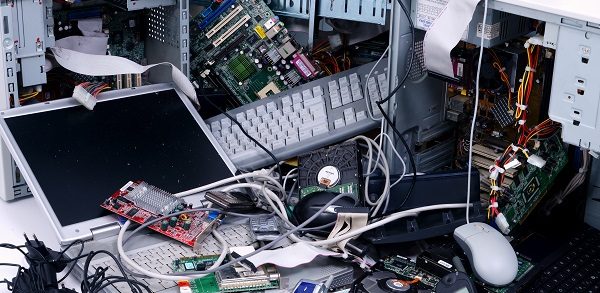
Despite its almost purely negative connotation, the e-waste amassing in startling proportions around the world is fostering an enormous amount of innovation and problem solving, especially in terms of recycling, reuse and repair.
In 2014, the then head of the United Nations Environmental Program, Achim Steiner, addressed a conference gathered in Nairobi to discuss the Basel Convention, a treaty developed with the help of the Basel Action Network to curb the illegal shipment of hazardous e-waste from rich nations to developing countries. He referred to the growing “mountain of e-waste” that is still creating a stir globally as consumerism continues its frenzied future course of heightened production.
Our mountain of e-waste is constantly growing and has created a crisis, but the fallout is not all negative. The slew of new and good ideas arising from the current e-waste crisis gives modern meaning to the old adage, necessity breeds invention, but are these ideas good enough and being implemented quickly enough to stymie an e-waste issue escalating at light speed around the world?
The Circular Economy
The concept of a circular economy has been gathering steam over the past decade. It’s a concept that incorporates sustainability in terms of recycling, repairing and reusing electronics in ways that keep them in circulation longer and out of the waste stream globally. This concept has the benefit of including electronics as a valuable source of multiple modern and rare necessities resources with enormous potential to decrease our reliance on resource-depleting economic development as well as the pollution associated with traditional mining.
The circular economy also envisions better design and manufacturing for electronics devices. This means encouraging electronics manufacturers to design in such a way that devices can be easily and safely discarded with less waste and more efficiency. It is a definite counter to the idea of planned obsolescence which can increase consumer upgrades and early disposal, rather than encourage repair, refurbishment and recycling.
Electronic Waste Recovery and Urban Mining
Waste recovery, and its related cousin, urban mining, are both solid ways to retain the valuable materials hidden inside electronic devices. Materials such as gold, silver, palladium and other rare and precious metals are the actual components found in the transistors, wiring, and motherboards of most devices. Electronic waste recovery and urban mining aim to acquire and reuse these valuable materials – before they are disposed and lost forever.
EPA Criminal Investigations
Two of the most prominent negative behaviors associated with e-waste are illegal dumping and illegal shipment to developing countries. These practices serve only to diminish the credibility of legitimate e-waste recycling operations and create terrible conditions of pollution and sickness in impoverished regions around the world.
Thankfully the EPA is holding culprits accountable. Companies and recyclers that violate federal and international laws meant to cut down on illegal dumping and illegal shipping of electronic waste often must face intense investigation and scrutiny from the EPA Criminal Investigation Department. Citizens that see or discover such criminal acts are encouraged to report it on the EPA website.
Tighter Regulations at Guiyu and Other Developing Regions
Guiyu, China had, for years, carried the unfortunate reputation as one of the most pollution infested, impoverished region of China. Due to shipment of e-waste from abroad heading straight to the region, Guiyu became a breeding ground for a host of unregulated waste recovery and recycling methods by citizens. As a result, its water systems, air and fields were completely devastated with high contents of some of the most dangerous chemicals known to man.
However, recent changes in Chinese government regulations have cleaned up the area significantly – almost overnight. The Chinese government cracked down on many of its imports of e-waste, calling for a huge cleanup of the waste and pollution of the area. Hopefully, countries with similar regions facing deterioration due to shipped e-waste can take note and follow suit.
Tighter Security and Regulations Worldwide
As the e-waste crisis gains exposure, and as information and alarm spread about the enormity of its exact nature, governments worldwide are beginning to create tighter security and regulations. Companies, concerned about the security risks involved when e-waste is improperly destroyed, are cracking down on information leaks that may occur post-discard.
This often involves choosing a responsible electronics recycler certified under the eStewards standards to ensure that private, highly sensitive data will be thoroughly contained and properly destroyed. The e-Stewards standard can also help ensure that the electronics are not being shipped overseas illegally.
The EPA now works in cooperation with international crime units to help crack down on illegal the transaction and trade of electronic devices worldwide. In addition, the Basel Action Network has helped track illegal shipments by monitoring the destination of electronics devices. Their reports have shed light on the numerous clandestine practices involved in electronics recycling and helped determined how the devices end up in the wrong hands and where these illegal transactions take place.
Great Ideas for E-waste and Electronics Recycling
The items noted here only scratch the surface of the problem-solving and creative solutions arising from an e-waste crisis that seems to be skyrocketing out of hand. New technology as well as new inspiration for repaired and second-life devices give tinkerers, artists, electronics manufacturers, educators, and even the average Joe an wide open field of exploration, innovation and creativity to discover.
The main point with any discussion on e-waste solutions is to explore new ways to prevent the dangerous environmental influences associated with electronics waste and disposal. Whether these solutions and ideas stem from the thought of improving production and design or simply keeping devices out of the waste stream for longer durations, they are all definitely crucial steps on the journey toward more sustainable solutions for e-waste.